Author: Sarah Crawford
UCT 2018
Event Name: Underground Construction Technology (UCT) 2018
Dates: January 30-February 1, 2018
Location: New Orleans, LA, USA
Venue: Ernest N. Morial Convention Center
The Robbins Company will be attending Underground Construction Technology 2018 January 30 through February 1. Be sure to visit our booth to learn more about Robbins Small Boring Units (SBUs)—the most cost effective and time efficient way to bore through hard rock.
Tunnel Turkey 2017
Event Name: Tunnel Turkey 2017
Dates: December 2-3, 2017
Location: Istanbul, Turkey
Venue: Wyndham Grand Istanbul Levent Hotel
The Robbins Company will be exhibiting at the 2017 International Tunneling Symposium, also known as Tunnel Turkey, in Istanbul December 2-3. In keeping with this year’s theme, “Challenges in Tunneling,” stop by stand S-4 to learn more about how Robbins overcomes our own challenging projects.
During the conference, be sure to attend, “Use of dual mode, crossover TBM to excavate challenging geology at Mexico City’s Emisor Poniente II Waste Water Tunnel” presented by Robbins Public Relations Manager, Desiree Willis. The presentation will take place on Saturday, December 2 at 2:00 pm.
Boring the Blue Mountains: The Inside Story on the World’s Fastest TBM
Over 20 years ago, a Robbins open-type machine set three world records while tunneling in the picturesque Blue Mountains in Australia. You may be asking yourself, why is this significant? Why drudge up a project that is surely outdated at this point in our industry’s history? The fact of the matter is, two decades have passed and the Robbins open-type TBM chosen for this project is still considered to be the world’s fastest TBM.
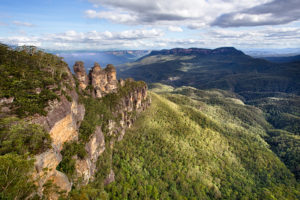
The picturesque Blue Mountains in New South Wales, Australia.
Project Background
In 1993, the 3.4 m (11 ft) diameter TBM was chosen to bore two sewage tunnels in the Blue Mountains near Sydney, Australia. At the time, there had been a rapid expansion of urban developments within the Blue Mountain National Park, causing an influx of pollution to enter streams as the result of septic tank runoff and outdated sewage treatment plants.
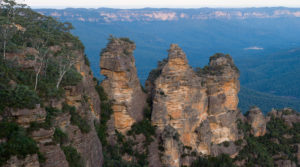
A closer look at the Three Sisters, a unique rock formation in the Blue Mountains.
The Blue Mountains Sewage Transfer Project comprised of approximately 40 km (25 mi) of tunnels, two of which were TBM-driven using the Robbins machine. The first, the Katoomba Carrier tunnel, was 13.4 km (8.3 mi) long and the second, the Lawson Carrier, was 3.5 km (2.1 mi) long. While the Lawson Carrier tunnel was finished five weeks prior to the expected completion date, it was during the Katoomba Carrier tunnel that all three records were set. During excavation the machine set the following world records: best day of 172.4 m (565.6 ft), best week of 702.8 m (2,305.7 ft), and a best monthly average of 1,189 m (39,000 ft) within its size range of 3 to 4 m (9.8 to 13.1 ft) diameter machine. Two of those records—the best day and best week—are the fastest ever recorded and have yet to be surpassed by any TBM of any size.
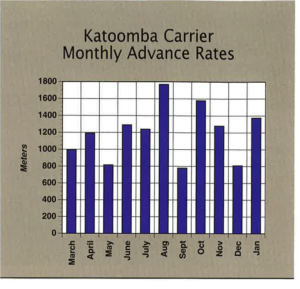
The 3.4 m (11 ft) diameter TBM set three world records while boring the Katoomba Carrier tunnel. Photo credit: tunneltalk.com
Custom Machine Design
There were many factors that played into this machine’s success—the system utilized on this project required a well-planned design, careful operation, and regular maintenance. As many people involved in tunneling know, choosing the right equipment for the geology can make or break a project. Detailed empirical data allowed the contractor to accurately predict what kind of ground they would encounter and prepare accordingly. The National Park is located within the Triassic Sydney Sedimentary Basin and is comprised primarily of sandstones and claystones. Anticipating this geology, the 3.4 m (11 ft) diameter machine’s cutterhead was dressed with 25 Robbins 17-inch diameter disc cutters designed for soft yet abrasive rock formations.
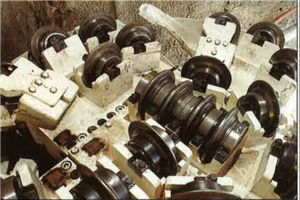
A close-up of the 17-inch cutters.
Logistics
The 13.4 km (8.3 mi) long Katoomba Carrier tunnel was originally planned to comprise of multiple short tunnels, several kilometers in length each, with intermittent portals to shorten drives. Ultimately it was decided to make the project one continuous tunnel, which led to higher advance rates and deemed it—at the time—the longest single-drive TBM tunnel. Not only did this change save time, but it also allowed boring to be less disruptive to the landscape.
Continuous Conveyor
In addition, the project was the first in Australia to utilize a continuous conveyor system. Due to the length of the tunnel, the use of traditional muck cars for muck removal would have taken too much time and were seen as an inadequate solution. The 106-m (347.8 ft) long system boosted production rates, with a best day of 1,565 m³ (55,267 ft³) of in-situ material removed from the Katoomba tunnel.
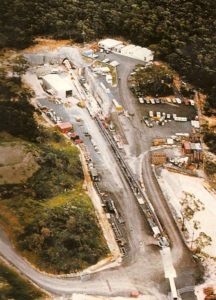
The Blue Mountains project was the first TBM-driven tunnel in Australia to utilize a continuous conveyor system.
Good Geology
Ground support throughout the tunnel comprised of a combination of resin grouted bolts, mesh, steel straps and steel sets. In the sturdier sandstone, however, the tunnel was left largely unlined and instead shotcrete was applied to areas of poorer, softer rock.
As boring progressed, the sandstone proved to be softer than expected. Instead of the predicted average of 80 MPa ranging from 20 MPa to 150 MPa, it averaged 40 MPa to 50 MPa with a range of 10 MPa to 100 MPa. This ideal material could also have contributed to the Robbins machine’s record breaking results and its early breakthrough, which occurred nine months ahead of schedule.
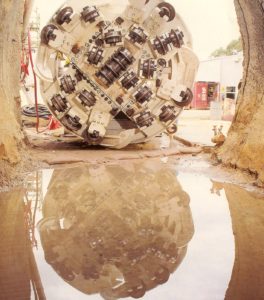
The machine’s record breaking boring enabled the project as a whole to finish 17 months ahead of schedule.
Exceeding Expectations
The Robbins Mk 12C’s performance on the tunnel boring portion of the project substantially surpassed all expectations. Not only did it set the previously mentioned world tunneling records, but it also helped the project as a whole finish 17 months ahead of schedule, saving not only on time but on significant financial costs.
Complimentary Webinar: Reducing Risk—How to Manage the Unknown in TBM Tunneling
Let’s face it: tunneling projects are inherently risky. The actual geology can harbor unforeseen conditions even with rigorous testing, and even when a highly-qualified consulting company creates the Geotechnical Baseline Report. In TBM-driven tunnels, the machine and the crew operating it are key components of the risk management strategy. So, how can we ensure that the tunneling operation is done effectively as often as possible?
In this complimentary 60-minute webinar from the manufacturer perspective, Robbins Chief Engineer Dennis Ofiara and Project Engineer Elisa Comis will explore that question, delving into contract structure, TBM design, case studies, and more to find the answer. Whether you’re a contractor operating the TBM, a consultant specifying the equipment, or an owner with an upcoming project, risk reduction is possible in even the most complex tunnels.
Click to View Recording of Webinar
AFTES 2017
Event Name: AFTES International Congress 2017
Dates: November 13-15, 2017
Location: Paris, France
Venue: Palais des Congrès
The Robbins Company will be joining NFM at this year’s French Tunnelling and Underground Space Association International Congress in Paris, France. Visit our shared booth from November 13-15, to discuss current projects and innovations within the industry.
ITA Tunneling Awards 2017
Event Name: ITA Tunneling Awards 2017
Date: November 15, 2017
Location: Paris, France
Venue: Salle Wagram
The Robbins Company is excited to announce that the recently completed Túnel Emisor Poniente (TEP) II has been nominated as an ITA Tunneling Awards finalist for Project of the Year. Winners will be announced at the ITA Tunneling Awards that will take place during the AFTES Congress in Paris, France on November 15.
The Robbins XRE TBM and its Robbins continuous conveyor system were built on location using Onsite First Time Assembly (OFTA), and featured components like a convertible cutterhead with interchangeable cutting tools, interchangeable TBM belt conveyor and screw conveyor, and multi-speed gearboxes to increase torque for tunneling through difficult ground. The 8.7 m (28.5 ft) diameter Robbins Crossover TBM bored a 5.8 km (3.6 mi) long wastewater tunnel, setting two national records in the process. The completed project will prevent flooding in urban areas and benefit the lives of 2.1 million people.
Mexico City’s Record-Breaking Crossover TBM Makes Final Breakthrough
On June 8, 2017, a select group of project officials, including Mexico’s President Enrique Peña Nieto, celebrated the final breakthrough of an epic tunneling project. The 8.7 m (28.5 ft) diameter Robbins Crossover TBM is the first such hybrid machine to operate in North America, and it completed the Túnel Emisor Poniente (TEP) II on a high note. The TBM, known as an XRE—a Crossover (X) between Rock (R) and EPB (E) TBMs—navigated fault zones, variable ground, low cover, and more to achieve a national record of 57 m (187 ft) in one day as well as maximum rates of 231 m (758 ft) in one week and 702 m (2,303 ft) in one month.
“The XRE has a great advantage as it is designed to work in open and/or closed mode (EPB); allowing it to excavate the tunnel either in soil or in rock. We’ve verified that its performance was very efficient,” said Ing. Juan Alberto Herrera Moro y Castillo, TEP II Section Chief for owner CONAGUA, Mexico’s National Water Commission.
The unique machine and its Robbins continuous conveyor system were built on location using Onsite First Time Assembly (OFTA), and designed for a contractor consortium of Aldesem, Proacon, and Recsa. The Robbins XRE TBM featured components like a convertible cutterhead with interchangeable cutting tools, interchangeable TBM belt conveyor and screw conveyor, and multi-speed gearboxes to increase torque for tunneling through difficult ground. “The benefits of the design are in its exceptional thrust power and in the ease of changing the cutterhead torque. This makes the process much easier should the machine become stuck in difficult ground,” said Alberto Martinez, head of the tunneling department for RECSA.
The XRE machine was launched in August 2015 to bore the 5.8 km (3.6 mi) long wastewater tunnel. The machine was set up in a hard rock configuration and mounted with 20-inch diameter disc cutters. Early in 2016 the TBM hit the first of several contact zones, a 30 m (98.4 ft) wide fault of fractured and blocky rock. While the excavation through the contact zone was slow going, progress picked up again in the more competent andesite rock. After an intermediate breakthrough in March 2016 into an 80 m (262.5 ft) deep shaft followed by inspection and maintenance, the TBM continued on.
While boring in fractured andesite rock in autumn 2016, the TBM encountered a naturally occurring cavern believed to be the result of either a rock fall in a transition zone, or an old, underground lake body that had eroded the rock away. The cavern was estimated at 90 cubic meters (3,200 cubic ft) in size, including about 57 cubic meters (2,010 cubic ft) of unstable floor area. The TBM was stopped and immediate measures were taken to stabilize the ground in front of the machine with polyurethane foam before filling the cavern with a mixture of pea gravel and grout.
By the end of October 2016, the TBM had reached a final 900 m (2,950 ft) long section of soft ground, where it was converted to EPB mode. In this final reach of tunnel with low cover, the distance from the top of the tunnel to residential home foundations was as low as 4 m (13 ft), and the ground had the consistency of reconsolidated soil. In order to stabilize the soft soils and minimize the risk of settlement below the residential area, the tunneling crew drilled from the surface and installed 890 micro-piles at 1.0 m (3.3 ft) intervals. “We were able to do this without causing damage to property owned by neighbors in the zone bordering the path of TEP II, or to the road or the urban infrastructure installed in that area,” explained Ing. Francisco Miguel Lopez, Jobsite Manager TEP II for contractor Aldesa.
Now that tunneling is complete, the tunnel will receive a secondary concrete lining of 35 cm (14 in) thickness before going into service. The wastewater tunnel will overhaul the current system in western areas outside of Mexico City and serve to prevent recurrent flooding in Valle Dorado. In particular, the tunnel will benefit the cities of Cuautital Izcalli, Tlalnepantla, and Atizapan de Zaragoza, which altogether are home to 2.1 million inhabitants.
Cutting Edge 2017
Event Name: Cutting Edge Conference
Dates: November 13-15, 2017
Location: Seattle, WA, USA
Venue: Renaissance Seattle Hotel
Join The Robbins Company at the Sixth Annual Cutting Edge Conference: Advances in Tunneling Technology November 13-15, in Seattle, WA. Visit our booth to learn more about current techniques being used on Robbins projects throughout the world.
STUVA 2017
Event Name: STUVA Expo and Conference
Dates: December 6-7, 2017
Location: Messe Stuttgart, Germany
Venue: Messe Stuttgart Trade Fair Centre
With an increasing rate of growth, STUVA-Expo will take place parallel to STUVA-Conference December 6-7 in Messe Stuttgart, Germany. The Robbins Company is looking forward to sharing information about current TBM projects operating world-wide at this ever-growing event.
EPB Excavation of Less Than Five Meters Below the Historic Structure of Chandpole Gate on the Jaipur Metro Project
The tunnels excavated by Continental Engineering Corporation (CEC) for the underground section of the Jaipur Metro project faced the usual challenges posed by metro projects worldwide, including small site footprints, and the associated problems regarding segment and muck storage space, etc. These challenges were, however, relatively straightforward when compared to the challenges faced by the tunneling operations. The Earth Pressure Balance (EPB) TBMs were required to bore under extremely low overburden, alongside and beneath several culturally sensitive historic structures. The age of these structures and their construction methods/materials were of great concern when considering the possible consequences of tunneling-induced ground settlement and vibrations. This paper will describe the measures taken regarding TBM operations and surface monitoring to ensure that these historic structures suffered no adverse effects due to tunneling.
Recent Posts
- Use of a Tunnel Boring Machine on Nepal’s First and Second TBM-Driven Tunnels
- Record-Setting Large Diameter Mixed Ground Tunneling in Turkey: The Eşme-Salihli Railway Tunnel
- Lessons Learned During Excavation of the Incredibly Challenging Yin Han Ji Wei Water Diversion Tunnel
- Record-Setting Tunnel Boring Below Lake Ontario at the Ashbridges Bay Outfall Tunnel
- Enhanced Probe Drilling & Pre-Grouting on Hard Rock TBMs

 Close
Close  Menu
Menu 